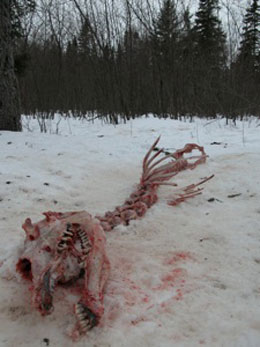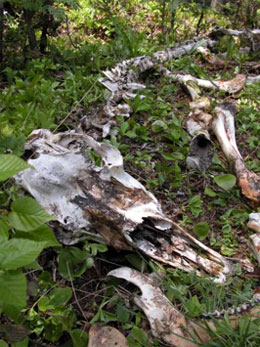Why Don't Wolves Eat All That They Kill?
A long-held opinion about wolves maintains they are wasteful gluttons that regularly kill more than they can eat. This misperception is one of several reasons that some people use to rationalize persecuting wolves. The wolf-moose project has been collecting information on carcass utilization for years. Every winter, when we see that wolves have finished feeding on a carcass and have left the area, we hike into that site and conduct a necropsy. As part of the necropsy, we answer a number of questions: How many bones are left? Have the legs, skull, and pelvis been disarticulated from the vertebral column? How many of the bones are still covered in hide?
We also document a rather precise relationship between this information and the proportion of the carcass that has been consumed. We have recorded this information on 293 carcasses killed by wolves in winter between 1995 and 2008. From these observations, we find that wolves typically consume between 91% and 95% of the edible portions of a carcass (i.e., the interquartile range is [0.91, 0.95]). And wolves almost always (90% of the time), consume at least 73% of the edible portions of a carcass.

Typical remains of a moose after wolves have finished eating it (above). Organ meat is the first to be eaten. Except in rare cases, all significant pieces of muscles are eaten. Ribs are typically eaten, bones are often partially consumed, and nearly all the hide is commonly eaten. Even the muscles that make up the lining of the stomach are eaten
Typical remains of a moose after wolves have finished eating it (above). Organ meat is the first to be eaten. Except in rare cases, all significant pieces of muscles are eaten. Ribs are typically eaten, bones are often partially consumed, and nearly all the hide is commonly eaten. Even the muscles that make up the lining of the stomach are eaten
Wolves typically eat most of the edible remains of a moose, and tend to utilize a carcass more fully during years when kill rates are lower. Each data point represents a population-wide average for each year between 1974 and 2008. Analogous patterns are observed in a wide range of species, including humans.
Occasionally wolves eat much less (above). But this circumstance is rare. This kill was made by just a few wolves deep within their territory. This image was taken when those wolves had left for a few days to defend the boundaries of their territory. Eventually they returned and consume all but the bones.
Nevertheless, it is interesting that wolves don’t eat every edible portion of a carcass. Why not? If it is so difficult to kill a moose, why not eat everything available? The question is of interest to more than just wolf biologists. This phenomenon of not eating all that you capture is so important and so wide-spread in the animal kingdom that scientists refer to it by a special phrase: partial-prey consumption. Partial-prey consumption has been observed and studied in various species of zooplankton, spiders, predaceous mites, insects, shrews, weasels, marsupials, canids, and bears. Even humans exhibit behaviors that are analogous to partial-prey consumption. Think, for example, about the food you leave behind on your dinner plate.
The idea is that when prey are relatively scarce it pays, obviously, to eat all that you kill. However, when prey are relatively easy to catch, it pays to eat only the good parts (or perhaps leave behind the least choice parts). It may take more effort than it is worth to chew and digest the last few bits of low quality scraps that remain after most of the carcass has already been eaten.So, why is partial-prey consumption so common? Ecologists have considered two possible explanations. The first possibility is that partial-prey consumption is a simple physiological constraint. That is, an animal doesn’t eat all that it’s killed because it is full. It cannot digest all that it has captured. An alternative possibility is that partial-prey consumption is an optimal foraging strategy—an intricate, albeit counterintuitive, behavioral adaptation shaped by natural selection.
These two ideas have been thoroughly tested for only two species, both were species of spider. One species seemed to be limited by physiological constraint and the other seemed to be exhibiting an optimal foraging strategy. We set out to test the idea for wolves. A critical test for distinguishing these patterns is to assess whether carcass utilization is greatest when food is most difficult to come by (or when kill rates are the lowest). If so, then there is a good chance the behavior represents an optimal foraging strategy. Sure enough, for Isle Royale wolves, we found carcass utilization to be greatest when kill rates were lowest (See figure at left).

Anything left behind by wolves is always consumed by some scavenger or decomposer. Ultimately, waste is not something with which ecosystems are familiar.
Wolves are not wasteful gluttons; they exhibit a behavior that has been observed in just about every species an ecologist has taken time to observe, and that behavior appears to be an optimal feeding strategy shaped by natural selection. Something like this pattern has even been observed in humans. Specifically, William Rathje, a garbologist from the University of Arizona, has observed that you tend to find more food in the trash of people living in higher-income neighborhoods. So, what is a wasteful glutton?
About The Project: Overview
Isle Royale is a remote wilderness island, isolated by the frigid waters of Lake Superior, and home to populations of wolves and moose. As predator and prey, their lives and deaths are linked in a drama that is timeless and historic. Their lives are historic because we have been documenting their lives for more than five decades. This research project is the longest continuous study of any predator-prey system in the world.















No comments:
Post a Comment